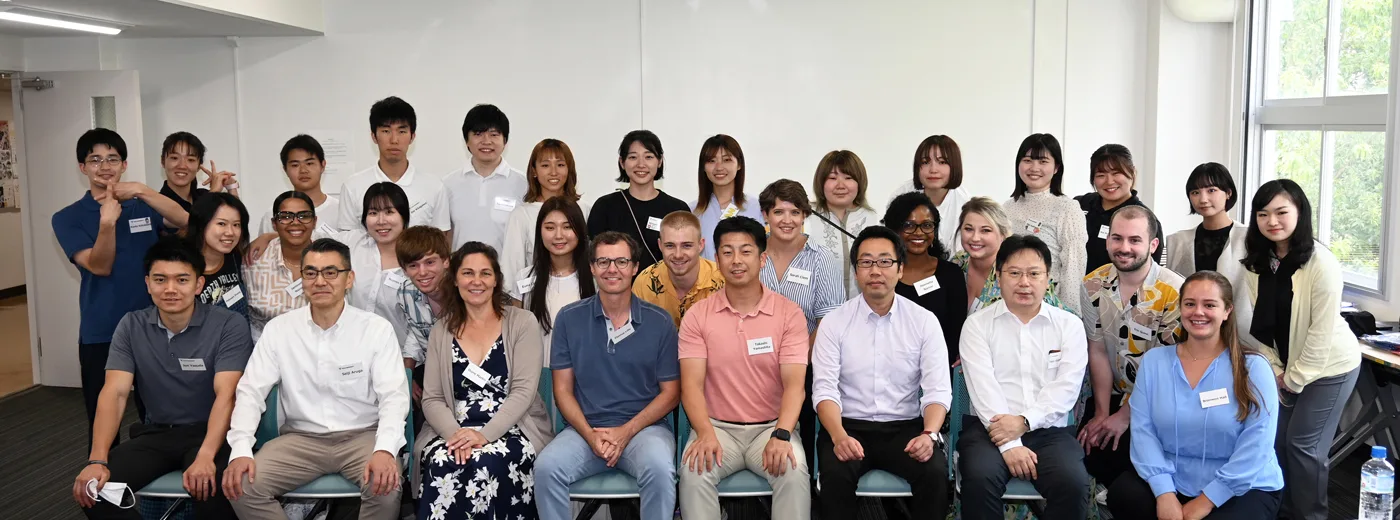
Graduate School of Health Studies and School of Health Studies welcomed students and faculty from the University of Maryland Graduate School in the United States to present their research, exchange opinions, and tour facilities at Shonan Campus on June 16. The Graduate School has students studying a wide range of fields, including gerontology, medicine, nursing, and social work, and for the first time organized a two-week training program to see and learn from the efforts of Japanese government, companies, universities, and private organizations in Japan's super-aging society. As part of the program, the students visited the Tokai University Department after being introduced by the International Strategy Group, Inochi/ Future Strategy Division, Policy Bureau, Kanagawa Prefectural Government Club Rooms.
At the beginning, students from Tokai University Graduate School Graduate School of Health Studies gave a welcome speech, and Professor Seiji Ariga introduced Tokai University and his own research, touched on the decline in muscle mass due to age, and discussed the benefits of training at nursing homes. I explained the situation and the changing fitness industry in Japan. Professor Fumiko Mega, Junior Associate Professor Jun Yasuda, Associate Professor Masaki Miyazawa, and Associate Professor Takeo Shibata then introduced their own research. Various topics such as changes in the local community, the need for muscle mass and protein intake, the development of new anticancer drugs, health bus initiatives, and health management using Graduate School apps will be explained. and actively exchanged opinions. After that, the faculty members of Tokai University and the students of the graduate school guided us around the research equipment and facilities in Building 5. In addition to measuring body composition, bone density, muscle mass, etc., we also challenged the "standing up test", which is one of the "locomo degree tests" installed in Building 5.
Takashi Yamashita Professor of the University of Maryland Graduate School commented, "The research at School of Health Studies was very broad and gave me a variety of perspectives, and I had a very meaningful time thinking about gerontology." Kyota Koitabashi (Graduate School Graduate School of Health Studies, first-year student), who was in charge of planning the facility tour, said, "I prepared for the tour by thinking about how to explain an idea that originated in Japan, like locomotive syndrome, and how to get people interested in our research field. It was difficult to explain in English, but I am glad that everyone listened with great interest. I hope we can continue to cooperate and exchange ideas in the future. Aruga Professor said, "We wanted the students to have an opportunity to look at the world and deepen their studies in their field of specialization and in English. While deepening exchanges among faculty members and students, we also hope that the students will be motivated to challenge themselves at international conferences.
Read more on Tokai University's website.
 Today, we had the pleasure of meeting with the governor of the Kanagawa prefecture. He discussed healthcare policies and innovations that have been put in place that support the ever growing super-aged population in Kanagawa. Two concepts in particular stood out, the first of which was known as Me-byo. Me-byo is a term used to express the state between health and sickness. Many tend to treat wellness as a binary scale; with healthy on one and end, and sick on the other. By acknowledging wellness on more of a sliding scale, we are better able to develop tactics to drive people of all ages to better health outcomes. The second concept that stood out was vibrant inochi. Promoting a vibrant inochi for all citizens is one of the driving forces of the healthcare policies put in place, and helps to set an excellent example for the health and wellness. After the presentation, we were able to explore the government building, and take in the beautiful view from the rooftop.
Today, we had the pleasure of meeting with the governor of the Kanagawa prefecture. He discussed healthcare policies and innovations that have been put in place that support the ever growing super-aged population in Kanagawa. Two concepts in particular stood out, the first of which was known as Me-byo. Me-byo is a term used to express the state between health and sickness. Many tend to treat wellness as a binary scale; with healthy on one and end, and sick on the other. By acknowledging wellness on more of a sliding scale, we are better able to develop tactics to drive people of all ages to better health outcomes. The second concept that stood out was vibrant inochi. Promoting a vibrant inochi for all citizens is one of the driving forces of the healthcare policies put in place, and helps to set an excellent example for the health and wellness. After the presentation, we were able to explore the government building, and take in the beautiful view from the rooftop. Vice Chancellor Flauvis Lilly of the University of Maryland Baltimore (UMB) in the U.S.A. and members of the student inspection and training program majoring in gerontology visited the prefectural office. The state of Maryland and the prefecture have signed a memorandum of understanding on cooperation in the field of life sciences as well as a friendship partnership. When I visited the state in October last year, I heard about the establishment of this training program from Vice Chancellor Lilly and others, and this visit to Japan was a realization.
Vice Chancellor Flauvis Lilly of the University of Maryland Baltimore (UMB) in the U.S.A. and members of the student inspection and training program majoring in gerontology visited the prefectural office. The state of Maryland and the prefecture have signed a memorandum of understanding on cooperation in the field of life sciences as well as a friendship partnership. When I visited the state in October last year, I heard about the establishment of this training program from Vice Chancellor Lilly and others, and this visit to Japan was a realization.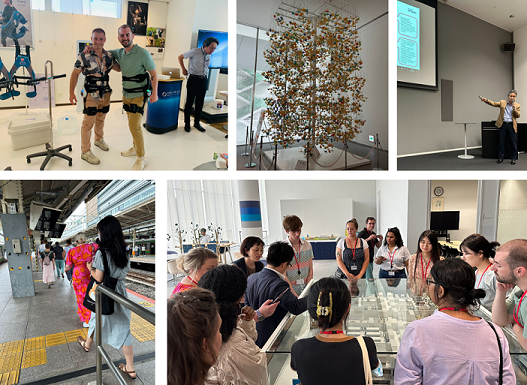 We started our day outside on a new train.
We started our day outside on a new train.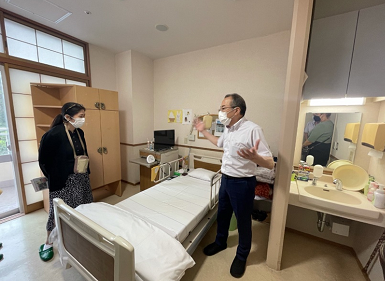 Today, we had the privilege of visiting a Choju-kai. Choju-kai is a nursing home that has been successfully operating since its founding in 1953. Here, long-term care, short-term care, and daycare services are offered for over 100 residents. There are approximately 100 staff working together at this facility to provide quality care for residents, including administration, nurses, kitchen staff, and occupational therapists. The mean age of all residents at Choju-kai is 92, and some residents have lived there for more than a decade!
Today, we had the privilege of visiting a Choju-kai. Choju-kai is a nursing home that has been successfully operating since its founding in 1953. Here, long-term care, short-term care, and daycare services are offered for over 100 residents. There are approximately 100 staff working together at this facility to provide quality care for residents, including administration, nurses, kitchen staff, and occupational therapists. The mean age of all residents at Choju-kai is 92, and some residents have lived there for more than a decade! Notably, the service cost was significantly lower than in the United States. With the help of long-term care insurance, a private room will cost approximately $1000 per month. Even without the insurance, the fee is around $3500 per month, which is still less than half of the average cost spent on nursing home facilities in the United States. Choju-kai is equipped with comprehensive amenities from a full kitchen, a medical suite, and a bathing facility to maintain and improve the residents' quality of life.
Notably, the service cost was significantly lower than in the United States. With the help of long-term care insurance, a private room will cost approximately $1000 per month. Even without the insurance, the fee is around $3500 per month, which is still less than half of the average cost spent on nursing home facilities in the United States. Choju-kai is equipped with comprehensive amenities from a full kitchen, a medical suite, and a bathing facility to maintain and improve the residents' quality of life.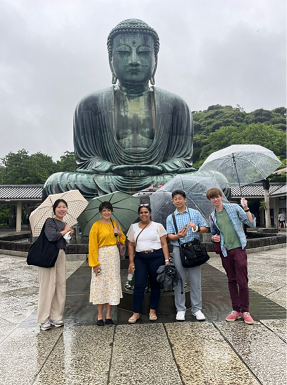 After visiting Choju-kai, we visited the Meigetsuin Temple, also known as the "hydrangea temple." Today was one beautiful rainy day, and blue hydrangeas were in full bloom. Lastly, we visited the great Buddha of Kamakura, which is 43 feet tall!
After visiting Choju-kai, we visited the Meigetsuin Temple, also known as the "hydrangea temple." Today was one beautiful rainy day, and blue hydrangeas were in full bloom. Lastly, we visited the great Buddha of Kamakura, which is 43 feet tall!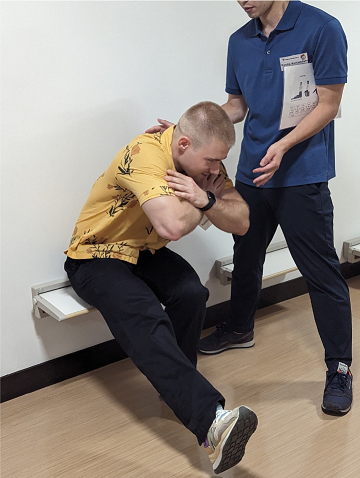 Today we became seasoned professionals at navigating Japan's public transportation system. We found a rhythm moving as a pack from train to bus and back again as we traveled around Kanagawa and Tokyo.
Today we became seasoned professionals at navigating Japan's public transportation system. We found a rhythm moving as a pack from train to bus and back again as we traveled around Kanagawa and Tokyo.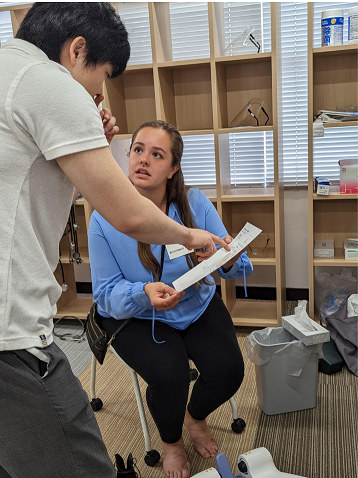 presentation at the World Health Organization. Both the presentation on healthy aging and the city views from the 34th floor left everyone impressed. The views continued to amaze as we headed up Tokyo Skytree, the tallest free-standing tower in the world. From the tower we caught our first glimpse of Mount Fuji in the distance.
presentation at the World Health Organization. Both the presentation on healthy aging and the city views from the 34th floor left everyone impressed. The views continued to amaze as we headed up Tokyo Skytree, the tallest free-standing tower in the world. From the tower we caught our first glimpse of Mount Fuji in the distance.
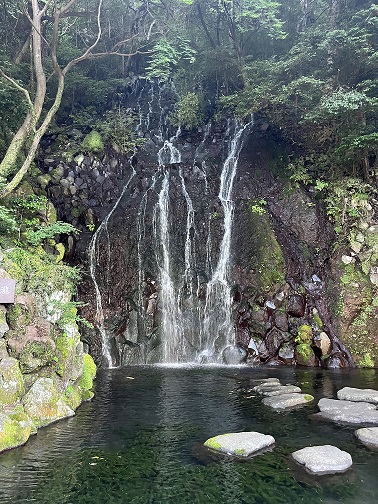 Our visit to Hakone, a rural area in Japan, has been an eye-opening experience. The region is known for its natural hot springs (known as onsens) and the stunning Mount Fuji. We had the opportunity to experience the cultural tradition of visiting an onsen, which was surprising due to its contrast to our own cultural norms. However, the experience proved to be both educational and enriching, allowing us to gain a deeper appreciation and understanding of other cultures worldwide.
Our visit to Hakone, a rural area in Japan, has been an eye-opening experience. The region is known for its natural hot springs (known as onsens) and the stunning Mount Fuji. We had the opportunity to experience the cultural tradition of visiting an onsen, which was surprising due to its contrast to our own cultural norms. However, the experience proved to be both educational and enriching, allowing us to gain a deeper appreciation and understanding of other cultures worldwide.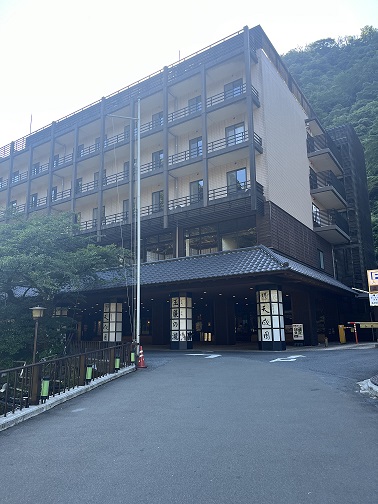 Hakone, despite being in a rural area, has a reliable public transportation system that makes it easily accessible to both visitors and residents. This convenience adds to the attraction of exploring the region, providing an opportunity to reflect and learn more about Japan and its cultural differences. It is remarkable to see how people of all ages in this country participate in different social activities as a community.
Hakone, despite being in a rural area, has a reliable public transportation system that makes it easily accessible to both visitors and residents. This convenience adds to the attraction of exploring the region, providing an opportunity to reflect and learn more about Japan and its cultural differences. It is remarkable to see how people of all ages in this country participate in different social activities as a community.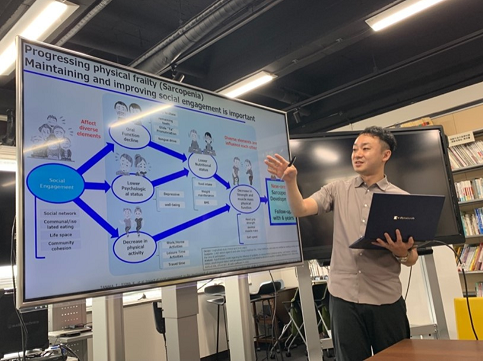 On June 20, we started our day with a wonderful visit to the Institute of Gerontology at the University of Tokyo (UoT). First, Prof. Katsuya
On June 20, we started our day with a wonderful visit to the Institute of Gerontology at the University of Tokyo (UoT). First, Prof. Katsuya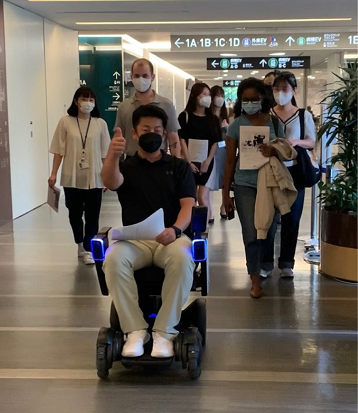 In the afternoon, we visited Keio University Shinanomachi Campus. Dr. Yasumichi Arai presented a fascinating study on Supercentenarians (older adults over 110 years old) as a part of Keio Global Initiatives. He shared with us that genes, a relatively warm environment, lifestyle (e.g., no smoking), and good health conditions and cognitive functions may contribute to an extremely long life span, but the effect of genes may only account for 20%.
In the afternoon, we visited Keio University Shinanomachi Campus. Dr. Yasumichi Arai presented a fascinating study on Supercentenarians (older adults over 110 years old) as a part of Keio Global Initiatives. He shared with us that genes, a relatively warm environment, lifestyle (e.g., no smoking), and good health conditions and cognitive functions may contribute to an extremely long life span, but the effect of genes may only account for 20%.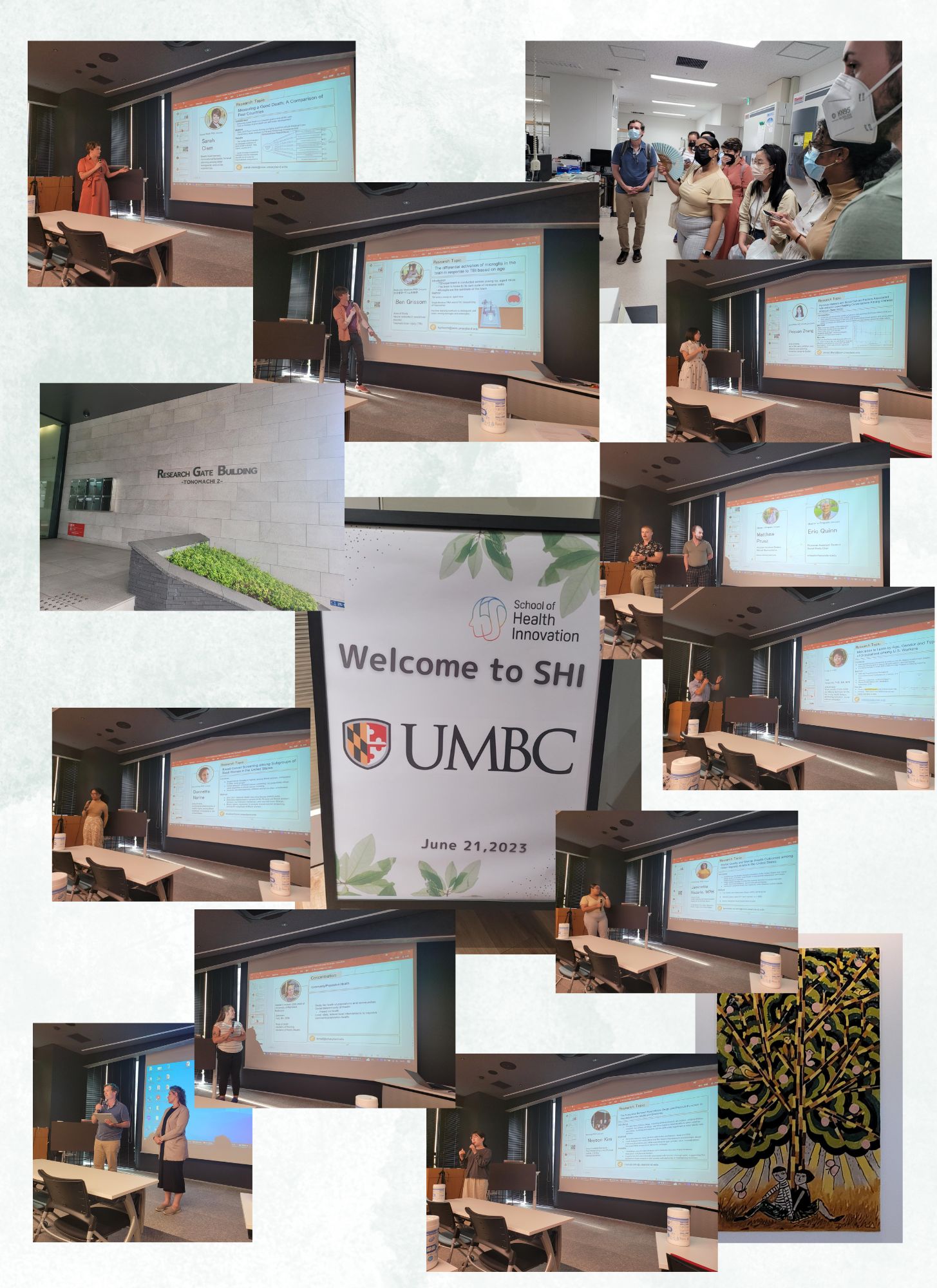 Today we spent the day with the wonderful professors, students, and employees from the Kanagawa Prefecture Cancer Center and the University of Human Services School of Health Innovation. In the morning we had the opportunity to learn about the groundbreaking work being done in the science of cancer in the older population here in Japan and how that can support future breakthroughs. We visited labs and their outpatient centers and were able to see what a typical day looks like for outpatient cancer patients receiving infusion therapy or visiting their physician.
Today we spent the day with the wonderful professors, students, and employees from the Kanagawa Prefecture Cancer Center and the University of Human Services School of Health Innovation. In the morning we had the opportunity to learn about the groundbreaking work being done in the science of cancer in the older population here in Japan and how that can support future breakthroughs. We visited labs and their outpatient centers and were able to see what a typical day looks like for outpatient cancer patients receiving infusion therapy or visiting their physician.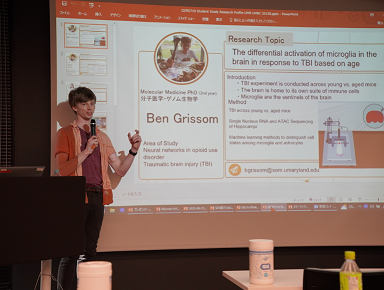 After starting the morning out with a hot bottle of coffee, a visit to my favorite little shrine, and a walk along the Toyouku flower greenway, I met the group for our day’s visits. First, we took a long hike to the Sotetsu line and headed out to the Kanagawa Cancer Center. Here we learned about the trends of cancer occurrence in an aging population from a group led by Dr. Narimatsu, chief of the Cancer Prevention and Control Division and direct of the Division of Genetic Medicine at the cancer center. One big takeaway I had here was that while older women were at greater risk for most varieties of cancer studied than older men, men have a higher incidence of lung cancer since they have a higher likelihood of a smoking history.
After starting the morning out with a hot bottle of coffee, a visit to my favorite little shrine, and a walk along the Toyouku flower greenway, I met the group for our day’s visits. First, we took a long hike to the Sotetsu line and headed out to the Kanagawa Cancer Center. Here we learned about the trends of cancer occurrence in an aging population from a group led by Dr. Narimatsu, chief of the Cancer Prevention and Control Division and direct of the Division of Genetic Medicine at the cancer center. One big takeaway I had here was that while older women were at greater risk for most varieties of cancer studied than older men, men have a higher incidence of lung cancer since they have a higher likelihood of a smoking history.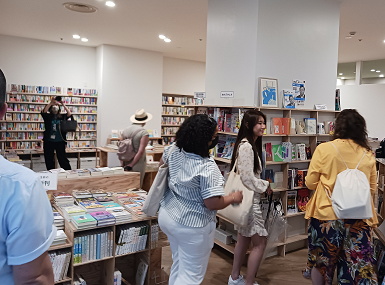 Social connection is an integral part of the human experience. However, it is not uncommon for older people to be socially isolated. Increased longevity can mean having more years to look forward to; at the same time, societies are arguably unprepared to support the continued engagement of older adults in later life. Post-retirement, older adults can find themselves on the periphery of society. Added to this, later-life changes in physical functioning and health status can challenge older adults’ mobility and thus their ability to maintain social connections. That said, loneliness and social isolation does not have to be the order of the day.
Social connection is an integral part of the human experience. However, it is not uncommon for older people to be socially isolated. Increased longevity can mean having more years to look forward to; at the same time, societies are arguably unprepared to support the continued engagement of older adults in later life. Post-retirement, older adults can find themselves on the periphery of society. Added to this, later-life changes in physical functioning and health status can challenge older adults’ mobility and thus their ability to maintain social connections. That said, loneliness and social isolation does not have to be the order of the day.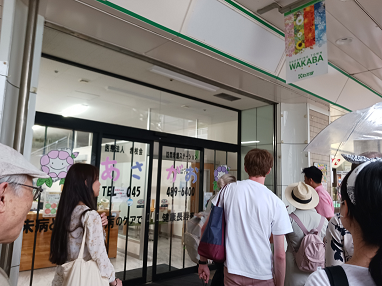 In fact, today’s tour of the Wakabadai housing complex showcased an intriguing example of a community that provides a quality life for older adults. Wakabadai supports social connection: older adults are actively engaged, particularly via volunteer service throughout the community; and older residents who live alone would frequently convene in communal spaces. Wakabadai also features a range of amenities including a grocery store, hair salon and bookstore. Prioritizing safety, vehicular traffic is separate from the pedestrian and bicycle paths. Built specifically for intergenerational living and thus intentional connection across generations, our visit to the Wakabadai housing complex was an insightful one.
In fact, today’s tour of the Wakabadai housing complex showcased an intriguing example of a community that provides a quality life for older adults. Wakabadai supports social connection: older adults are actively engaged, particularly via volunteer service throughout the community; and older residents who live alone would frequently convene in communal spaces. Wakabadai also features a range of amenities including a grocery store, hair salon and bookstore. Prioritizing safety, vehicular traffic is separate from the pedestrian and bicycle paths. Built specifically for intergenerational living and thus intentional connection across generations, our visit to the Wakabadai housing complex was an insightful one. On our last day in Yokohama, we convened for a final reflective conversation. After sharing our contemplation on the goals we established prior to this trip, we quickly progressed into conducting an in-depth discussion on the interplay between various fields (e.g., business, government policy, healthcare, and research) positively impact endeavors towards long-term care and quality of life of the older population in Japan.
On our last day in Yokohama, we convened for a final reflective conversation. After sharing our contemplation on the goals we established prior to this trip, we quickly progressed into conducting an in-depth discussion on the interplay between various fields (e.g., business, government policy, healthcare, and research) positively impact endeavors towards long-term care and quality of life of the older population in Japan.